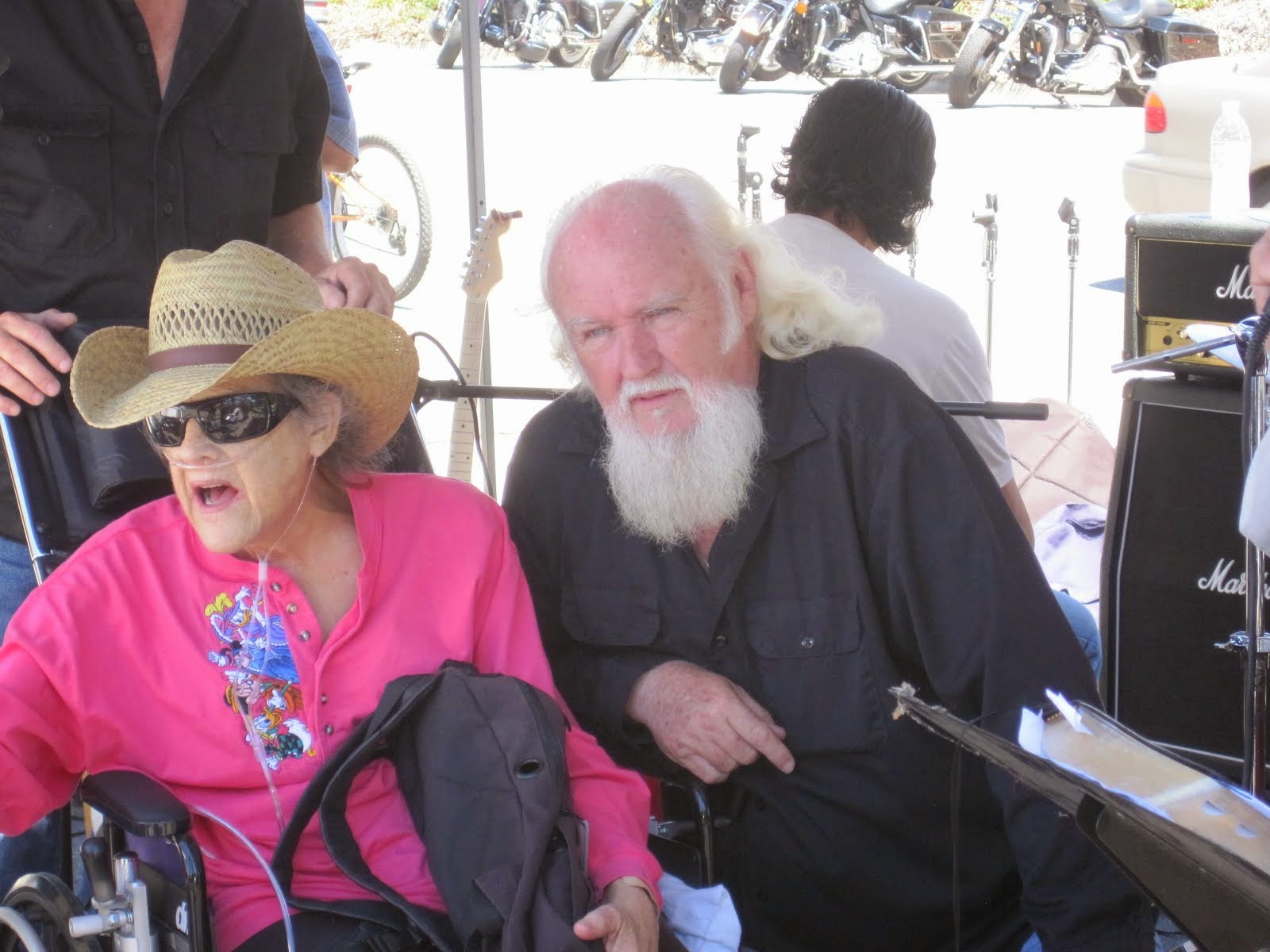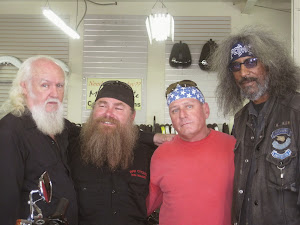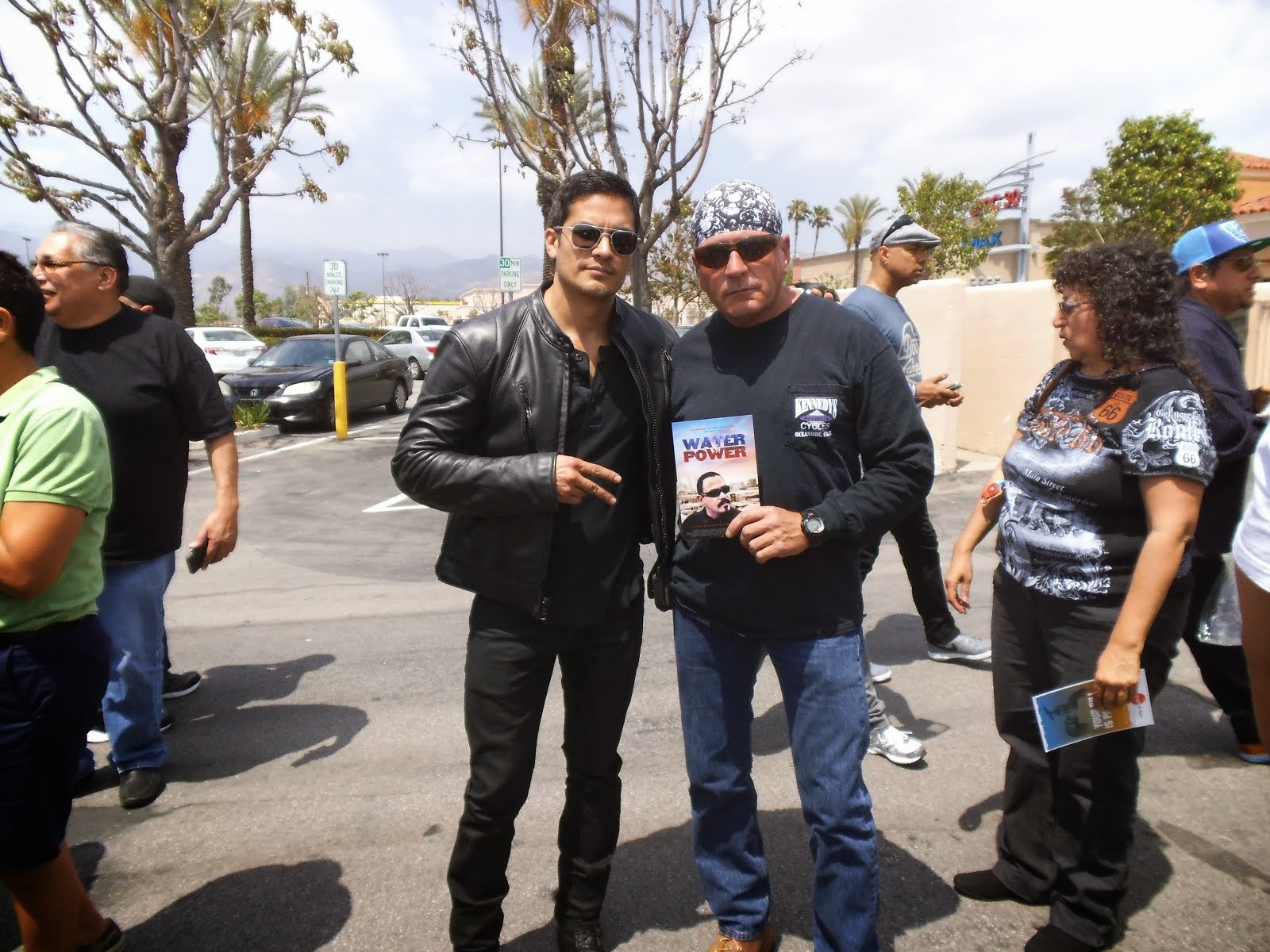OFF THE WIRE
1%er defined
NOTE: This is the defininition given in Wiki-pedia, if you belive anything to be an error, please e-mail us and we will check it out.
One Percenters, Gangs and Outlaws.
Motorcycle clubs are often perceived as criminal organizations or, at best, gangs of hoodlums or thugs by traditional society. This perception has been fueled by the movies, popular culture, and highly publicized isolated incidents, the earliest of which was a brawl in Hollister, California in 1947 between members of the Boozefighters MC (motto: a drinking club with a motorcycle problem) and the Pissed Off Bastards MC (precursor to the Hells Angels).
The press asked the American Motorcyclist Association (AMA) to comment, and their response was that 99% of motorcyclists were law-abiding citizens, and the last one percent were outlaws. Thus was born the term, "one percenter".
During the 1940's and 1950's, at rallies and gatherings sponsored by the AMA, prizes were awarded for nicest club uniform, prettiest motorcycle, and so forth. Some clubs, however, rejected the clean-cut image and adopted the "one percenter" moniker, even going so far as to create a diamond (rhombus) shaped patch labeled "1%" to wear on their vests as a badge of honor.
The 1% patch is also used to instill fear and respect from the general public and other motorcyclists. Other clubs wore (and still wear) upside down AMA patches.
*Another practice was to cut their one piece club patches into three or more pieces as a form of protest, which evolved into the current form of three piece colors worn by many MCs today.
One percent clubs point out that the term simply means that they are simply committed to "biking and brotherhood", where riding isn't a weekend activity, but a way of living. These clubs assert that local and national law enforcement agencies have co-opted the term to paint them as criminals.
While it is a fact that individual members of some MCs, and even entire chapters have engaged in felonious behavior, other members and supporters of these clubs insist that these are isolated occurrences and that the clubs, as a whole, are not criminal organizations. They often compare themselves to police departments, wherein the occasional "bad cop" does not make a police department a criminal organization, either.
At least one biker website has a news section devoted to "cops gone bad" to support their point of view.
Many one percenter clubs, including the Hells Angels, sponsor charitable events throughout the year for such causes as Salvation Army shelters and Toys for Tots.
Alternatively, both the Federal Bureau of Investigation (FBI) and Criminal Intelligence Service Canada (CISC) have designated certain MCs as Outlaw Motorcycle Gangs (OMGs), among them the Pagans, Hells Angels, Outlaws MC, and Bandidos.
Canada, especially, has experienced a significant upsurge in crime involving members and associates of these MCs, most notably in what has been dubbed the Quebec Biker war.
Some members of the Hells Angels MC have been indicted on various charges, including RICO charges, murder, robbery, extortion, trafficking in stolen and VIN-switched motorcycles, methamphetamine and cocaine distribution.
In April, 2006, eight members or associates of the Bandidos MC were found murdered in a farm field in Ontario, Canada in what police have described as an internal cleansing of the Bandidos organization. One of the men charged with the murders is, himself, a Bandidos MC full patch member.
As recently as September 29, 2006, the president and another officer of the San Francisco chapter of the Hells Angels were indicted on charges of methamphetamine and cocaine distribution.
skip to main |
skip to sidebar




Bill & Annie

Art Hall & Rusty


NUFF SAID.......


































































OOHRAH

ONCE A MARINE,ALWAYS A MARINE

GIVING BACK


MOUNT SOLEDAD














BIKINI BIKE WASH AT SWEETWATER










FRIENDS





BILL,WILLIE G, PHILIP










GOOD FRIENDS


hanging out

brothers


GOOD FRIENDS

Good Friends

Hanging Out




Bill & Annie
Art Hall & Rusty
Art Hall & Rusty


NUFF SAID.......



















NUFF SAID......



























Mount Soledad




BALBOA NAVAL HOSPITAL
RUSTY DANNY

ANNIE KO PHILIP

PHILIP & ANNIE

OUT & ABOUT

OOHRAH...

OOHRAH
ONCE A MARINE,ALWAYS A MARINE

ONCE A MARINE,ALWAYS A MARINE
American Soldier Network GIVING BACK

GIVING BACK
CATHY & BILL
PHILIP & DANNY & BILL

MOUNT SOLEDAD
bills today
EMILIO & PHILIP
WATER & POWER
WATER & POWER
bootride2013



BIKINI BIKE WASH AT SWEETWATER







ILLUSION OPEN HOUSE

FRIENDS


GOOD FRIENDS



BILL,WILLIE G, PHILIP









GOOD FRIENDS

GOOD FRIENDS
Friends
- http://www.ehlinelaw.com/losangeles-motorcycleaccidentattorneys/
- Scotty westcoast-tbars.com
- Ashby C. Sorensen
- americansoldiernetwork.org
- blogtalkradio.com/hermis-live
- davidlabrava.com
- emiliorivera.com/
- http://kandymankustompaint.com
- http://pipelinept.com/
- http://womenmotorcyclist.com
- http://www.ehlinelaw.com
- https://ammo.com/
- SAN DIEGO CUSTOMS
- www.biggshd.com
- www.bighousecrew.net
- www.bikersinformationguide.com
- www.boltofca.org
- www.boltusa.org
- www.espinozasleather.com
- www.illusionmotorcycles.com
- www.kennedyscollateral.com
- www.kennedyscustomcycles.com
- www.listerinsurance.com
- www.sweetwaterharley.com

Hanging out

hanging out
Good Friends

brothers
GOOD FRIENDS

EMILIO & SCREWDRIVER

GOOD FRIENDS
Danny Trejo & Screwdriver

Good Friends
Navigation
Welcome to Bikers of America, Know Your Rights!
“THE BIKERS OF AMERICA, THE PHIL and BILL SHOW”,
A HARDCORE BIKER RIGHTS SHOW THAT HITS LIKE A BORED AND STROKED BIG TWIN!
ON LIVE TUESDAY'S & THURDAY'S AT 6 PM P.S.T.
9 PM E.S.T.
CATCH LIVE AND ARCHIVED SHOWS
FREE OF CHARGE AT...
BlogTalkRadio.com/BikersOfAmerica.
Two ways to listen on Tuesday & Thursday
1. Call in number - (347) 826-7753 ...
Listen live right from your phone!
2. Stream us live on your computer: http://www.blogtalkradio.com/bikersofamerica.
A HARDCORE BIKER RIGHTS SHOW THAT HITS LIKE A BORED AND STROKED BIG TWIN!
ON LIVE TUESDAY'S & THURDAY'S AT 6 PM P.S.T.
9 PM E.S.T.
CATCH LIVE AND ARCHIVED SHOWS
FREE OF CHARGE AT...
BlogTalkRadio.com/BikersOfAmerica.
Two ways to listen on Tuesday & Thursday
1. Call in number - (347) 826-7753 ...
Listen live right from your phone!
2. Stream us live on your computer: http://www.blogtalkradio.com/bikersofamerica.
Good Times
Hanging Out

Key Words
- about (3)
- contact (1)
- TENNESSEE AND THUNDER ON THE MOUNTAIN (1)
- thinking (1)
- upcoming shows (2)
Blog Archive
-
▼
2020
(125)
-
▼
April
(11)
- A Blueprint For Successfully Protesting “No Motorc...
- 1%er defined - One Percenters, Gangs and Outlaws.
- Oh No! More Covid-19!
- The Covid-19 Panic
- How Long ??????
- Idaho Passes Anti-Motorcycle Profiling Law
- Colorado Sheriffs Cover-Up Shooting Hells Angel In...
- Waco Day 1817
- Seized And Terrorized
- The Imminent Mongols Indictment
- Mongols Menace Alleged
-
▼
April
(11)
Bikers of America, Know Your Rights!... Brought to you by Phil and Bill
Philip, a.k.a Screwdriver, is a proud member of Bikers of Lesser Tolerance, and the Left Coast Rep
of B.A.D (Bikers Against Discrimination) along with Bill is a biker rights activist and also a B.A.D Rep, as well, owner of Kennedy's Custom Cycles
